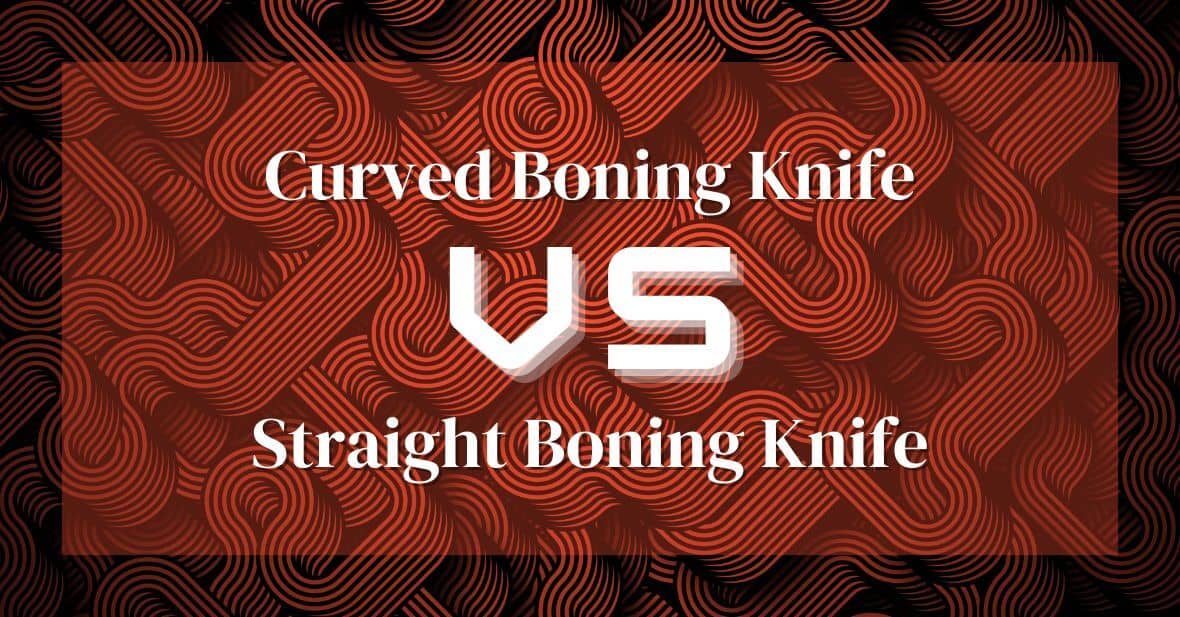Curved vs Straight Boning Knife: Which Shape Cuts It Best?
Are you a chef who can’t decide between a curved or straight boning knife? It’s understandable – after all, the stakes are high! Without the right blade, your delicious dishes can quickly become disasters.
But don’t worry – this article will show you which type of knife is best for your culinary needs. You’ll learn about the anatomy of a boning knife, pros and cons of curved and straight knives, factors to consider when choosing one, and our top recommended knives.
So before you plunge into culinary chaos with an ill-suited blade, read on and sharpen up your knowledge!
Anatomy of a Boning Knife
Knowing the anatomy of a boning knife can help you decide which one’s right for you! Boning knives come in two basic designs: curved and straight.
The blade shape is important, as it determines how effective the knife will be at cutting through meat and bones. Curved blades are generally used to cut around joints, while straight blades are more suitable for filleting delicate fish or slicing through larger cuts of meat.
It really comes down to personal preference — what works best for you? When it comes to choosing a boning knife, look for something that feels comfortable in your hand and has a sharp blade that won’t dull quickly.
A good-quality handle should provide plenty of grip so that you don’t slip when using the knife. You should also consider investing in a protective sheath so that your knife stays sharp and safe when not in use.
Ultimately, whether you opt for curved or straight boning knives depends on what type of tasks you plan to use them for!
Pros and Cons of Curved Boning Knives
You’ll find that a curved blade gives you more control and precision when it comes to separating meat from bone because the curved shape allows for better access to hard-to-reach areas that are close to bone. So, you can make smooth cuts with greater accuracy. Plus, the shape of the curve also makes it easier to apply more force without compromising your butchering technique.
While curved blades require a different sharpening technique than straight blades, they also typically retain their edge longer due to their unique design.
With all this in mind, there are some drawbacks of using a curved boning knife as well. They don’t work as well in tight spaces or on thin bones where precision is key. They can be heavier and more difficult to maneuver than straight knives too, making them less ideal for long periods of use or for smaller hands. Lastly, since they come in specialized shapes and sizes, they tend to be more expensive than traditional straight knives.
Pros and Cons of Straight Boning Knives
With a straight blade, you can easily access tight or narrow spaces and make precise cuts without having to worry about extra weight or difficulty maneuvering. Straight boning knives offer a great combination of design and blade steel that makes them ideal for the job. For instance, the slim profile of the knife allows it to get into those hard-to-reach places, while also providing enough strength for tough tasks like deboning poultry. Additionally, with its simple shape and sharp edge, these blades make quick work of even the finest cuts of meat.
The main downside to straight boning knives is that they can be difficult to control in larger joints due to their lack of curvature. However, if you’re careful and take your time when using one, it can still do an excellent job at cutting through even the toughest pieces of meat. Another potential disadvantage is that they often require more effort than curved boning knives since there isn’t as much surface area on the blade to help with pushing through thicker bones. | Pros | Cons | | —–|——| | Slim profile | Difficult to control on larger joints | | Sharp edge | More effort required than curved boning knives | | Strength for tough tasks such as deboning poultry | Lack of curvature limits surface area on blade for pushing through thicker bones | | Easier to maneuver in tight spaces than curved boning knives |
Factors to Consider When Choosing a Boning Knife
When selecting a knife for cutting tasks, you’ll want to consider the size, shape, and materials used in order to find the perfect fit for your needs. Deciding between a curved or straight boning knife is an important part of this process. Here are some factors to keep in mind when choosing between them:
- Shape: If you’re looking for precision and accuracy with each cut, then a straight-bladed knife will offer more control than its curved counterpart. On the other hand, if you need to maneuver around bones or joints, then a curved blade can help make those cuts easier.
- Blade Material: Boning knives usually come with stainless steel blades that are either flexible or rigid. A flexible blade is better suited for cutting thinner pieces of meat while a rigid one is preferred for tougher cuts like beef ribs and pork shoulder.
- Handle Design: When shopping for boning knives, look for ones with comfortable handles that provide good grip and balance while working in wet environments such as kitchens and butcher shops. Additionally, make sure the handle fits comfortably into your hand so it’s easy to use over long periods of time.
No matter which type of boning knife you choose, curved or straight, it should be sharp enough to get the job done quickly without much effort from you! So don’t forget to take these factors into consideration before making your decision – after all, finding the right tool can make all the difference!
Recommended Boning Knives
Discover the perfect boning knife for your needs – whether you’re looking for accuracy or maneuverability – with a range of sizes, materials, and handle designs. When evaluating what knife is right for you, consider factors such as size and weight.
If you need to do precise cutting techniques like deboning poultry or fish, then a curved boning knife may be most suitable. This style of blade allows for maneuverability in tight spaces and detailed work. But if you’re looking to trim fat from larger joints like pork chops or beef steaks, then a straight-bladed boning knife might be ideal due to its longer length and balanced weight distribution.
And don’t forget about maintenance: whichever type of blade you choose, make sure it’s easy to sharpen and keep clean so that it will remain sharp long-term!
Conclusion
When it comes to boning knives, it’s all about personal preference. Whether you opt for a curved or straight blade, the key is finding a knife that feels comfortable in your hand and has the right weight and balance. The best way to make your decision is by trying out both styles and seeing which one works best for you.
Don’t forget: as with any purchase, buy the best quality knife that fits your budget — otherwise, it could be a case of ‘penny wise, pound foolish’!
Frequently Asked Questions
What Is The Best Way To Sharpen A Boning Knife?
Sharpening a boning knife is an important part of keeping it in top condition. The best way to sharpen it is by hand, whether you’re working with a curved or straight blade. This method allows for better control and accuracy when honing your blade’s edge.
Plus, if you’re careful, you can avoid removing too much metal or damaging the coating on your knife’s blade. Just be sure to start with a coarse-grit sharpening stone and work up to a finer one for the perfect edge!
How Often Should A Boning Knife Be Replaced?
You take pride in your knife collection and know that proper maintenance is key to keeping the blades sharp. But how often should you replace a boning knife? Generally speaking, if you’re taking good care of your blade and practicing regular knife care, it can last for years.
This includes regularly honing the blade with a steel rod or whetstone and keeping it clean and dry after each use. If you notice any nicks or chips in the blade, however, it’s probably time to get a new one.
It’s important to note that curved vs straight boning knives may require different levels of maintenance and replacement frequency based on their design.
Is There A Size Difference Between Curved And Straight Boning Knives?
When it comes to knife types, the differences between curved and straight blades can be seen in more than just their shape. While both are boning knives, they also come in different sizes. Curved blades are shorter and straighter blades are longer. This difference in size allows them to be used for different purposes. The curved blade is great for making precise cuts around bone or cartilage. On the other hand, the longer straight blade is better suited for larger pieces of meat.
The best way to determine which size you need is by looking at what type of cutting job you’re attempting. If precision matters most, reach for a smaller curved blade. If speed and power are your top priorities, then pick up a larger straight-bladed boning knife!
What Is The Best Type Of Handle For A Boning Knife?
When it comes to choosing the best handle for a boning knife, you want something that offers good grip comfort and a design that fits your hand perfectly. Whether you prefer a classic wood handle or something more modern like rubber or synthetic material, there are many options available to find the perfect fit for you.
The important thing is to make sure it’s comfortable, so you can easily control the blade while de-boning meats and fish. And let’s face it, if your boning knife handle isn’t comfortable then what’s the point? Comfort is key when selecting your new boning knife!
Are Stainless Steel Boning Knives Better Than Carbon Steel Ones?
Are stainless steel boning knives better than carbon steel ones? It’s quite the debate!
If you’re looking for a lightweight option, stainless steel is usually the best choice. On the other hand, if you have an ergonomic design in mind and want to ensure maximum blade hardness and longevity, then carbon steel is ideal.
Plus, sharpening techniques are easier to master with a carbon steel boning knife.
So when it comes down to it, both stainless and carbon steel have their pros and cons – so it really depends on what you’re looking for!
Additional Resources
19 Types of Kitchen Knives & Their Uses
Western Style Knives 101 | A Comprehensive Introduction to the Basics
The Art of the Slice: A Dive into Japanese Knife Types
The Art of Butchery: Use of a Boning Knife for Precise Meat Preparation
Forging Culinary Excellence: The Best Steel For Kitchen Knives

